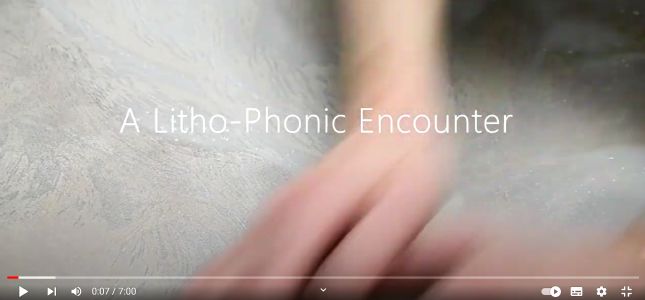|
|
Writing on stone: the generative intersection between language and lithography
A
world of academic discourse that shares knowledge through word and image frames
this Phd thesis in which I explore the relationship between stone lithography
and language - ‘language’ being understood here in its widest sense as written
text, embodied, vocal and tacit communication, symbolic and excess information,
visual image, and the means through which thought becomes manifest and
subjectivity is expressed. At the core of the inquiry is the artisanal practice
of stone lithography: a technology that led the development of printed
communications in the nineteenth century as both a method of mass
communication, and an emerging artists’ technique. Invented by the Bavarian playwright Alois
Senefelder (1771-1834), stone lithography had a significant impact on the world
of music publishing, and I draw on this lyrical inheritance of song, dance and
spoken word. I also draw on the dark legacies of colonialism that laid the
ground for the development of lithography in the Age of Empire. In the light of these historic contexts, my
own studio practice, and a transdisciplinary field of knowledge, this collection
of texts explores the multi-modal breadth of lithographic language making and demonstrates
the heterogenous nature of the languages engendered by the practices of stone
lithography.
PhD thesis Loughborough University Repository. 2024. Full text >>
Heteroglossia
'Valued for centuries, for their medicinal, toxic, or industrially useful properties, in the Victorian era these consumable resources were traded as the justifiably claimed bounty from a fertile planet. Today, these gleaned, cultivated, extracted, and commodified, products of global economies, might also be understood as the subterranean residue of primordial events, geo-political forces, and exploited lives. Quarried from the earth’s crust and harvested from the living and the dead, silently present in these traded goods, are genealogies that indivisibly embed these so-called natural resources, in both the transactional ecologies of colonialism and its afterlives, and the elemental matter of sentient life.'
From Heteroglossia, a cosmic glossary of lithographic terms and materials. Digitally published on ISSUE, 2023. Full text >>
'Called to
mind by the captured glimpse of [Skiold] inking the stone: the rhythmic tack of
rotating pressure and ink, increasing warmth of roller cuffs clasped between
fingers and palm, and sleight of hand that enables the spindle of a roller to
be momentarily held still, or released to move freely. These acts that signal
the ‘tacit knowledge’ of inherited practice (Polyanyi 1967) might also be
understood as both the
‘breathing flesh’ (Crawley 2013) and language of an
artisan lithographer, and as the gestures of a materialising cosmos; palpable
vibrations of matter in hand through which the universe might be intimately
known (Weil 1947,141).'
IMPACT 12 Conference Proceedings, 2020. Bristol: UWE. Full text>>
Listen: a litho-phonic encounter
'It is not only lithographers who have noticed the sonorous properties of limestone. Archaeologists and musicians have also heard the audible vibrations of a sonic landscape left by the traces of evolution. Familiar to stonemasons checking for cracks and flaws, and to geologists using the knock of a hammer to detect subtle changes in lithology, the acoustic properties of stone have been known since Neolithic culture […]'
Nature: Humanities and Social Sciences Communications. 2020.10, 341. Full text >>
A Litho-Phonic Encounter 7 minute video 
'Traversing the topography
of this substrate, the tracks of these movements cluster and intersect. Lines
of travel collide and converge. And as the tracing and re-tracing, repeats and
returns, left within the membrane is a manuscript that documents journeys taken
and territories charted. Laid down in
the process is the fragmented text of notation - a choreographic inscription in
which might be glimpsed, an arabesque performed in the nexus between generative
systems, time, and the intentions of life on the move.'
'Under a clear blue sky, the dragonfly takes its last migration through breezeless air. Touching down momentarily on still water, too late to know that this salty pool won’t quench a thirst, its fragile wings are pulled down into the sedimenting basin of an isolated lagoon. Just out of reach from the coast nothing leaves the stagnating pool and warmed by the sun the water slowly evaporates. Under the same sky 150 million years later, in a territory now under the jurisdiction of a place called Bavaria, the once calm reef is now land with a settled population. Business thrives in a town becoming renowned for its rich deposit of finely sedimented limestone and quarry beds are excavated to feed a growing demand for this now valuable natural resource being traded in the printing industry. And once again, by chance, the small creature’s last journey comes to light, each detail of its flesh depicted in the smooth surface of the soft limestone matrix.' Inscription: the Journal of Material Text - Theory, Practice, History. 2020 Issue 1. Full text >>
The Reside Residency ‘At a first glance, not to disturb the ground I trod carefully, thinking the creature might still be there. But on closer inspection the snake had gone, eased itself out, neatly shed the skin, and moved on. Leaving behind this translucent doppelganger, a ghostlike facsimile of every scale. For millennia, this elegant undressing must have been repeated. Remembered in the tracery of this discarded shell, imprinted in the geometric design of interlocking filigree, duplicated in each cell of the intricate patina, returned to and replayed, each time the same but different; the force of nature's habit.’
|
|

